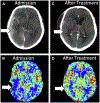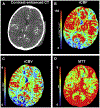Perfusion Imaging in Acute Traumatic Brain Injury
- PMID: 29157853
- PMCID: PMC7890940
- DOI: 10.1016/j.nic.2017.09.002
Perfusion Imaging in Acute Traumatic Brain Injury
Abstract
Traumatic brain injury (TBI) is a significant problem worldwide and neuroimaging plays a critical role in diagnosis and management. Recently, perfusion neuroimaging techniques have been explored in TBI to determine and characterize potential perfusion neuroimaging biomarkers to aid in diagnosis, treatment, and prognosis. In this article, computed tomography (CT) bolus perfusion, MR imaging bolus perfusion, MR imaging arterial spin labeling perfusion, and xenon CT are reviewed with a focus on their applications in acute TBI. Future research directions are also discussed.
Keywords: Concussion; Perfusion; TBI; Traumatic brain injury.
Copyright © 2017 Elsevier Inc. All rights reserved.
Figures






References
-
- Faul M, National Center for Injury Prevention and Control (U.S.). Traumatic brain injury in the United States : emergency department visits, hospitalizations, and deaths, 2002-2006. http://purl.fdlp.gov/GPO/gpo41911.
-
- Marin JR, Weaver MD, Yealy DM, Mannix RC. Trends in visits for traumatic brain injury to emergency departments in the United States. Jama. 2014;311(18):1917–1919. - PubMed
-
- Centers for Disease C, Prevention. Nonfatal traumatic brain injuries related to sports and recreation activities among persons aged </=19 years--United States, 2001-2009. MMWR Morbidity and mortality weekly report. 2011;60(39):1337–1342. - PubMed
-
- Corrigan JD, Selassie AW, Orman JA. The epidemiology of traumatic brain injury. The Journal of head trauma rehabilitation. 2010;25(2):72–80. - PubMed
-
- Bass E, Golding H, United States. Congressional Budget Office. The Veterans Health Administration's treatment of PTSD and traumatic brain injury among recent combat veterans. A CBO study. Washington, DC: Congress of the United States, Congressional Budget Office,; 2012: http://purl.fdlp.gov/GPO/gpo18872.
Publication types
MeSH terms
Grants and funding
LinkOut - more resources
Full Text Sources
Other Literature Sources
Medical

